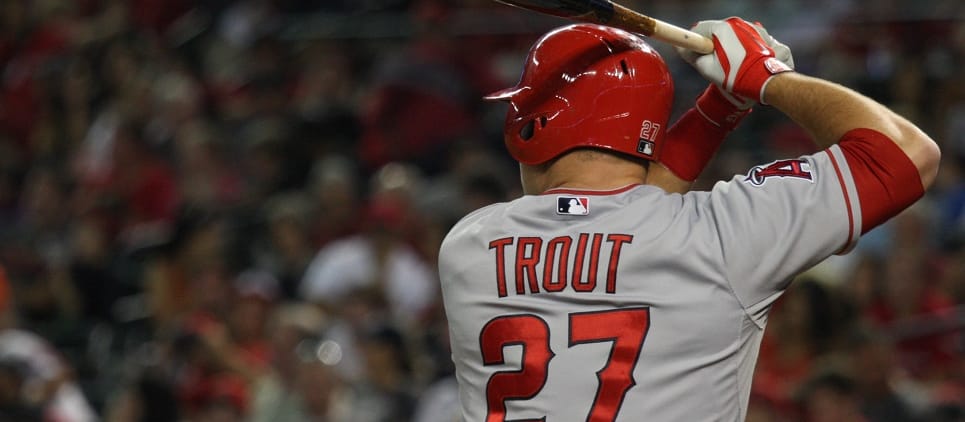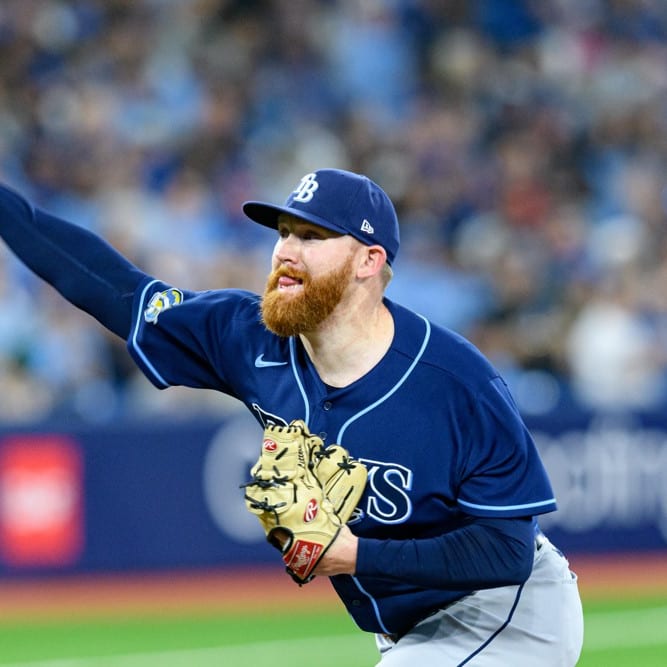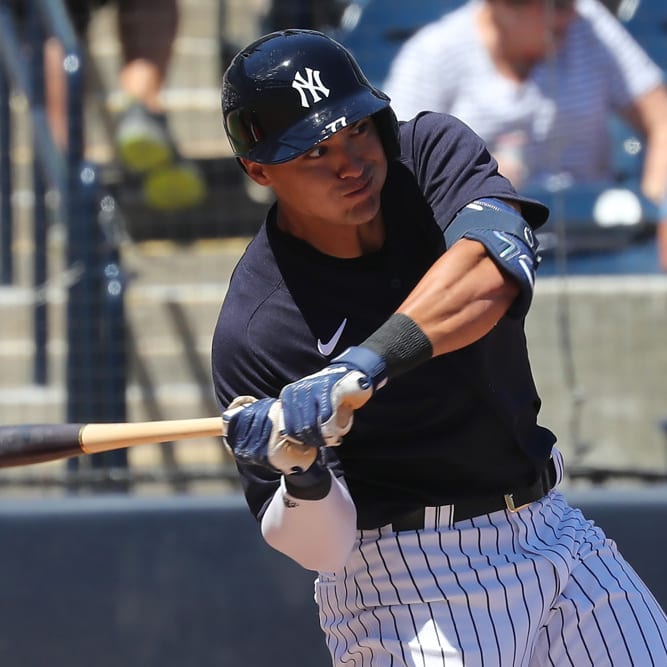This article is part of our DFS Baseball 101 series.
For many baseball fans-particularly those of us with a little more "life experience" on our tires-the back of our prized baseball cards served as our statistical hub for each player long before the advent of the Internet. There we knew we'd find what we thought was the be-all, end-all collection of numbers that gave us a thorough picture of that player's success, or lack thereof, year-to-year throughout his career.
Out with the Old, In with the New!
We're all well aware of how far we've come from the days of what are now almost considered "primitive" metrics, and many modern-day fans, analysts and DFS players alike would scoff at the notion of simply looking at seasonal stats to determine much of anything about any given player. When looking at baseball performance in 2016, we break things down to a per-pitch level in an attempt to evaluate a player's body of work as finely as possible, and extract the most predictive value we can from each metric in the process.
That's left some of our old stand-by measuring sticks for baseball performance-such as batting average-as proverbial relics gathering dust in the corner. The old tried-and-true parameters that conventional batting average conditioned us to evaluate hitters by have now largely become outdated, especially when measured up against its flashier and much more sophisticated descendant: Weighted On-Base Average (wOBA)
The Ins and Outs of wOBA
One of the easier things to do as a beginning MLB DFS player is be overwhelmed by the array of rather alien jargon and acronyms that seem to be commonly tossed around. However, your basic understanding of conventional batting average actually serves as a formidable foundation to quickly grasp the gist of wOBA.
Simply put, wOBA is a figure designed to remove many of the vagaries inherent in conventional batting average. It was developed by a baseball sabermetrics analyst with the alias of Tom Tango, whose goal was to measure a player's overall offensive value as accurately as possible. Granted, there was certainly a time in baseball analytics when we believed that batting average did a perfectly fine job. For instance, we were taught to believe that anyone hitting under .250 was pretty much a poor hitter, and anyone who reached the .300 mark was stellar at the plate. While making these general assumptions may have often been accurate in a roundabout way, we never knew what ingredients had gone into cooking up that three-digit figure. For instance, did that lauded .305 average consist of a heavy dose of singles and walks, or was there a healthy heap of doubles and homers?
Therein lies the overarching purpose of wOBA: to eliminate the ambiguity of what makes up conventional batting average by appropriately differentiating the various ways in which a player can get on base. In other words, just as doubles, triples and home runs are progressively more valuable in a real baseball game, they hold progressively more weight when calculating a hitter's wOBA. In this manner, wOBA gives you a better feel for how much impactful contact the hitter is making on each trip to the plate, with the exception of intentional walks, which the hitter has no control over and are therefore not factored in as a plate appearance. As we already know with respect to DFS scoring, the more impactful the contact, the bigger the haul of fantasy points.
For those with an interest in learning more about the actual weight distribution for each hitting "event" that goes into calculating wOBA, Fangraphs provides a breakdown of the formula in their sabermetrics library. Since a quick glance may produce unpleasant flashbacks for some to those advanced algebra or calculus courses, we're glad to report that wOBA information is conveniently and commonly provided on a wide variety of DFS analytics and research platforms, already packaged into one neat, three-digit figure.
Using wOBA in Making DFS Lineup Decisions
Now that we've begun to establish what a potent analytical tool wOBA is, how exactly do we deploy it to help set our daily fantasy baseball lineups? There are multiple ways in which wOBA can guide our decisions, on both pitchers and hitters, in terms of who to target and who to avoid. It's prudent to start by getting a basic feel-just as we did long ago when we became familiarized with conventional batting average-of our parameters of performance.
What qualifies as league average wOBA varies from season to season, and the exact weight used for each hitting event in the wOBA formula does as well. As a general rule, it's helpful to know that wOBA is set to league average on-base percentage (OBP), so it will closely parallel that figure in any given season. Without getting too complex, a chart that serves as a very good guide for the various wOBA benchmarks in any given season is provided by Fangraphs in a table entitled "wOBA Rules of Thumb," which can be found here. Utilizing the information in that matrix allows one to see, for example, that in most seasons, anyone sporting at least a .340 wOBA is enjoying an above-average campaign at the plate. Conversely, anyone whose wOBA dips below the .311 mark is considered below average. As you can see, it's a far cry and requires a paradigm shift from how the latter figure would have been considered in the realm of conventional batting average.
With that data in hand, we can naturally ascertain a hitter's overall offensive value at any given point in the season by having a look at his wOBA, and this can certainly be key in helping us make decisions for our daily fantasy baseball lineups. However, as with all metrics, it's prudent to go below the surface, as each day in MLB DFS can be markedly different, particularly considering matchups.
As we've established, individual matchups are paramount when setting lineups in daily fantasy baseball, and wOBA splits are a terrific day-to-day tool. By evaluating both a hitter's and pitcher's wOBA splits against both handedness of opposition, you can often identify exploitable matchups and "stay-away" scenarios. For example, one of the most common types of wOBA patterns is seen in the success that left-handed hitters have against right-handed pitchers, and conversely, that of right-handed hitters against southpaws. The considerable wOBA disparity between a lefty batter's performance against righties as compared to that of pitchers that match his handedness can therefore serve as one of the most important factors in helping you reach a decision on whether or not to include that player in your lineup on that particular day.
Case Study in wOBA Splits: the Rangers' Mitch Moreland
To provide a more tangible example, we'll examine the case of Rangers left-handed veteran slugger Mitch Moreland, who predictably, has feasted on right-handed pitching throughout his career. Moreland has a solid .342 wOBA against righties over his six-plus seasons. As we know from our earlier look at how wOBA gives a weight to each hitting event that reflects its respective value within the actual field of play, Moreland's figure is very likely to consist of the type of impactful hits that would be of benefit to your fantasy point total. Sure enough, a closer look reveals that Moreland has tallied 82 doubles, three triples and 78 home runs over the 1,758 plate appearances that he's had against right-handed pitchers in his career.
Predictably, when we look at his track record against left-handed pitching, we see a much less impressive resume. Moreland has mustered a lackluster .288 wOBA and only 12 of his 90 career homers against southpaws over 555 plate appearances. Clearly then, on those rather rare occasions when Moreland is in the lineup against a left-handed starter, we can easily steer clear of including him in our daily fantasy baseball lineup in favor of other options with much more favorable matchups.
Evaluating Pitchers Through wOBA
Naturally, we can also utilize wOBA to either build a case for or disqualify a pitcher when putting together a daily fantasy baseball lineup. By reviewing a pitcher's respective wOBA metrics against left and-right-handed hitters, we can reach certain conclusions about their viability, or lack thereof, against a particular team on that day. For example, Braves right-hander Julio Teheran has proven to be especially inept against left-handed hitters throughout five-plus major league seasons, surrendering a robust .350 wOBA over a 1,367-batter sample to left-handed hitters, along with 60 doubles, 10 triples and 50 homers over that span. Conversely, he's consistently stymied right-handed batters, holding them to an outstanding .259 wOBA over a 1,343-batter sample.
What does Teheran's example illustrate for us? We can easily avoid using him in our daily fantasy baseball lineups on days when he's facing a lefty-heavy lineup, or when the opposing team has several proficient left-handers in the heart of the order who could do some serious damage against him. However, if we want to consider him against a primarily right-handed lineup in a situation that also has some other favorable factors, such as a pitcher-friendly ballpark like Teheran's home stadium of Turner Field, then it could be a prudent choice depending on salary and the DFS contest type you're playing.
Importance of Sample Size
As with any other metric in baseball, sample size absolutely needs to be considered. The validity of a hitter's wOBA naturally increases with the sample size, and as with other data, we can easily be misled if we don't take the time to do our research. For example, if one were to have examined Mike Trout's overall 2016 wOBA numbers after the first week of action in the new season, they would have looked drastically uglier than his outstanding .399 and .408 respective figures against lefties and righties. Furthermore, in addition to ensuring we're reviewing a solid amount of plate appearances when considering hitters-- and innings when we're evaluating pitchers-- we also want to have a look at year-by-year breakdowns.
We'll cite Giants veteran right-hander Matt Cain as an example for this final point. Cain has been a solid major league pitcher overall, tallying four straight double-digit win seasons between 2009 and 2012. The success of those campaigns largely played a role in Cain's very good career .290 wOBA versus righty hitters. However, some injury concerns and advancing age began changing the landscape beginning in 2013. A look at his season-by-season wOBA breakdown since that point reveals progressively increasing figures of .307, .310 and .357 over the next three seasons, respectively. While the early going of 2016 had seen him have better results against righties, we're once again reminded of the importance of sample size. In that situation, a three-season history of progressively decreasing success versus that handedness of hitter, coupled with his arm being a year older, would seem to point to an eventual regression, despite the recent outlier numbers stemming from a very minor sample.
An Essential DFS Tool When Used Correctly
As illustrated, wOBA is a versatile and valuable metric for trying to gauge a hitter's potential upside for your daily fantasy baseball lineup. Conversely, it can also help you hone in on a pitcher, and can certainly help you identify trouble spots for both batters and pitchers that you'll want to avoid. When used in conjunction with other supporting analysis-and when keeping factors such as sample size under consideration-it can undoubtedly serve as a key component of your daily fantasy baseball research.












